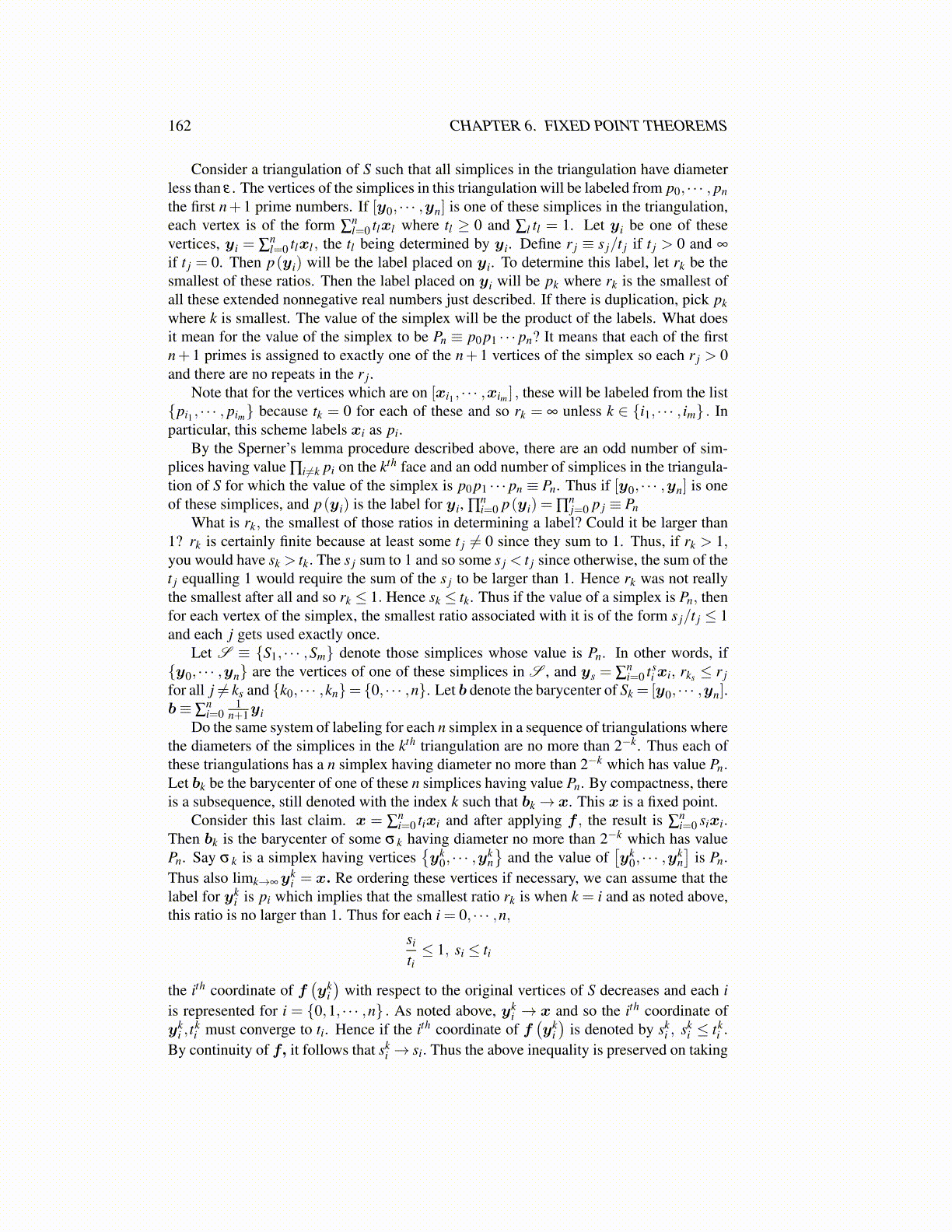
162 CHAPTER 6. FIXED POINT THEOREMS
Consider a triangulation of S such that all simplices in the triangulation have diameterless than ε . The vertices of the simplices in this triangulation will be labeled from p0, · · · , pnthe first n+1 prime numbers. If [y0, · · · ,yn] is one of these simplices in the triangulation,each vertex is of the form ∑
nl=0 tlxl where tl ≥ 0 and ∑l tl = 1. Let yi be one of these
vertices, yi = ∑nl=0 tlxl , the tl being determined by yi. Define r j ≡ s j/t j if t j > 0 and ∞
if t j = 0. Then p(yi) will be the label placed on yi. To determine this label, let rk be thesmallest of these ratios. Then the label placed on yi will be pk where rk is the smallest ofall these extended nonnegative real numbers just described. If there is duplication, pick pkwhere k is smallest. The value of the simplex will be the product of the labels. What doesit mean for the value of the simplex to be Pn ≡ p0 p1 · · · pn? It means that each of the firstn+1 primes is assigned to exactly one of the n+1 vertices of the simplex so each r j > 0and there are no repeats in the r j.
Note that for the vertices which are on [xi1 , · · · ,xim ] , these will be labeled from the list{pi1 , · · · , pim} because tk = 0 for each of these and so rk = ∞ unless k ∈ {i1, · · · , im} . Inparticular, this scheme labels xi as pi.
By the Sperner’s lemma procedure described above, there are an odd number of sim-plices having value ∏i ̸=k pi on the kth face and an odd number of simplices in the triangula-tion of S for which the value of the simplex is p0 p1 · · · pn ≡ Pn. Thus if [y0, · · · ,yn] is oneof these simplices, and p(yi) is the label for yi, ∏
ni=0 p(yi) = ∏
nj=0 p j ≡ Pn
What is rk, the smallest of those ratios in determining a label? Could it be larger than1? rk is certainly finite because at least some t j ̸= 0 since they sum to 1. Thus, if rk > 1,you would have sk > tk. The s j sum to 1 and so some s j < t j since otherwise, the sum of thet j equalling 1 would require the sum of the s j to be larger than 1. Hence rk was not reallythe smallest after all and so rk ≤ 1. Hence sk ≤ tk. Thus if the value of a simplex is Pn, thenfor each vertex of the simplex, the smallest ratio associated with it is of the form s j/t j ≤ 1and each j gets used exactly once.
Let S ≡ {S1, · · · ,Sm} denote those simplices whose value is Pn. In other words, if{y0, · · · ,yn} are the vertices of one of these simplices in S , and ys = ∑
ni=0 ts
i xi, rks ≤ r jfor all j ̸= ks and {k0, · · · ,kn}= {0, · · · ,n}. Let b denote the barycenter of Sk = [y0, · · · ,yn].b≡ ∑
ni=0
1n+1yi
Do the same system of labeling for each n simplex in a sequence of triangulations wherethe diameters of the simplices in the kth triangulation are no more than 2−k. Thus each ofthese triangulations has a n simplex having diameter no more than 2−k which has value Pn.Let bk be the barycenter of one of these n simplices having value Pn. By compactness, thereis a subsequence, still denoted with the index k such that bk→ x. This x is a fixed point.
Consider this last claim. x = ∑ni=0 tixi and after applying f , the result is ∑
ni=0 sixi.
Then bk is the barycenter of some σ k having diameter no more than 2−k which has valuePn. Say σ k is a simplex having vertices
{yk
0, · · · ,ykn}
and the value of[yk
0, · · · ,ykn]
is Pn.
Thus also limk→∞yki = x. Re ordering these vertices if necessary, we can assume that the
label for yki is pi which implies that the smallest ratio rk is when k = i and as noted above,
this ratio is no larger than 1. Thus for each i = 0, · · · ,n,si
ti≤ 1, si ≤ ti
the ith coordinate of f(yk
i)
with respect to the original vertices of S decreases and each iis represented for i = {0,1, · · · ,n} . As noted above, yk
i → x and so the ith coordinate ofyk
i , tki must converge to ti. Hence if the ith coordinate of f
(yk
i)
is denoted by ski , sk
i ≤ tki .
By continuity of f, it follows that ski → si. Thus the above inequality is preserved on taking